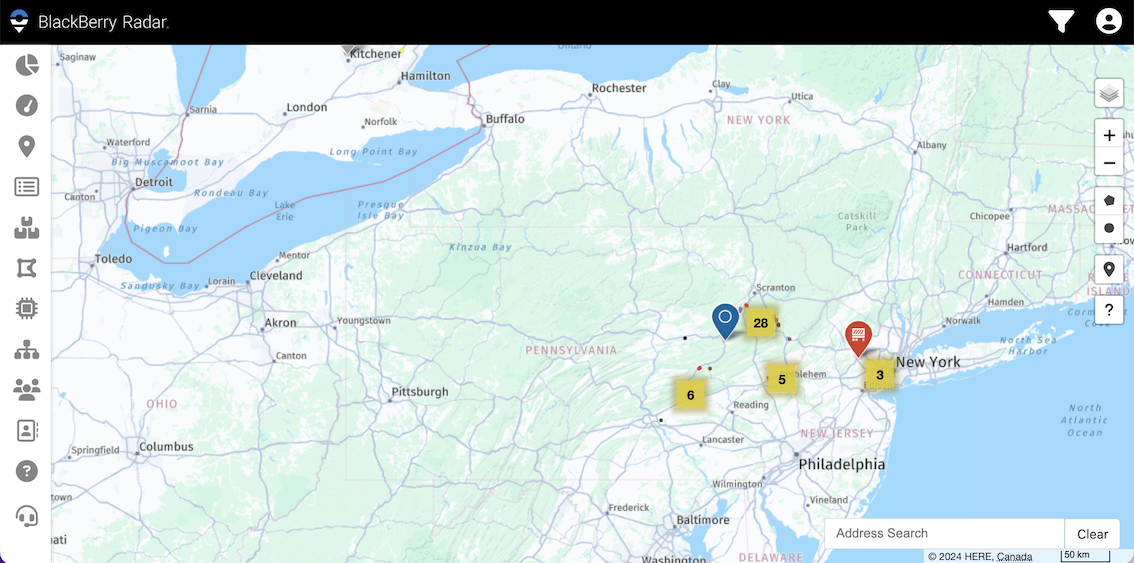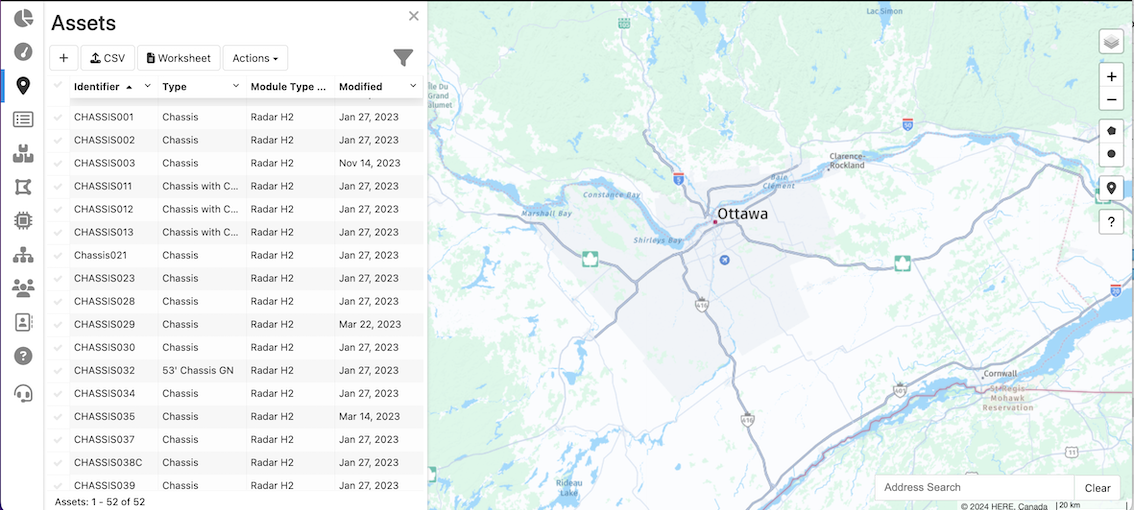BlackBerry Radar Dashboard
You can use the BlackBerry Radar Dashboard application to view asset information and track asset activities on the Dashboard map.
This section helps you to get started. For complete BlackBerry Radar documentation, log in to the BlackBerry Radar Dashboard and visit documentation using the sidebar menu.
Assets, modules and geofences
First, let's clarify a few terms that the Dashboard application uses:
- Asset: A trailer, chassis, or container, onto which a BlackBerry Radar device is installed. When an asset is associated with a BlackBerry Radar device (module), you can use the Dashboard application to track the asset.
- Module: A BlackBerry Radar device that is installed on an asset. You may find a few different module types: Radar-M, Radar-L, and Radar-H2. The different module types are equipped with different sensors, and therefore, allow you to track different asset data.
- The Radar-M module is able to track:
- Location
- Movement
- Cargo state
- Battery state
- Door state
- Temperature
- Humidity
- Air pressure
- Estimated distance traveled
- The Radar-L and Radar-H2 modules are able to track:
- Location
- Movement
- Battery state
- Door state
- Estimated distance traveled
- Radar-H2 modules with accessories may be able to track container state, cargo state, and environmental features, depending on the accessory installed.
- The Radar-M module is able to track:
- Accessory: An accessory device, installed along with a module, that provides additional sensors.
- Geofence: An area on the map defined for asset tracking purposes. For example, a geofence can be used to represent a yard, a store, or a distribution center.
Localized Dashboard
To view the Dashboard application in a different language, click the user button  in the upper right corner and select Settings.
in the upper right corner and select Settings.
By default, the Radar Dashboard uses metric units. You may switch to imperial units.
Sign in
Note: If you are a new user, we have sent you a welcome email with your username and a temporary password.
- Go to BlackBerry Radar and click Log In.
- Enter your email address and password, and click Sign In.
- If multiple customer accounts are managed under this user name, select the customer account from the dropdown menu.
- Click the Select Customer Account button.
Invite new users
If you are an administrator, you can invite new users by adding them to the application using the Users menu. When you add a new user, an email notification is sent to that user.
For information about how to add a user, log in to the Dashboard application and visit the documentation from the main menu.
Note: The invite email will be sent from a radar.blackberry.com address (for example, no-reply@radar.blackberry.com). Make sure that you (the admin) advise your users to allow emails from that source, and to check their spam folders if they don't see the email.
The Dashboard map

On the Dashboard map, you may find various markers. For example, each blue, or red pin represents an asset. Each colored polygon represents a geofence. If you move your cursor over the asset or geofence marker, you will see its name.
Buttons and menu options on the map allow you to access more information about your assets.
- Clicking an asset brings up detailed information about that asset.
- Clicking on a geofence brings up detailed information about that geofence.
- The zoom in
 , zoom out
, zoom out  and map layers
and map layers  buttons at the upper right corner of the map allow you to tailer the map view to your need.
buttons at the upper right corner of the map allow you to tailer the map view to your need. - Use the filter button
 in the upper right corner to access various filters.
in the upper right corner to access various filters.
Dashboard views
The Dashboard main menu includes a list of menu options that allow you to access different aspects of the asset tracking information.

Each menu option opens a view. The examaple below shows the Assets view. You can click on any asset to access more detailed information.

Sign out
- Click the user button
 in the upper right corner above the map.
in the upper right corner above the map. - Select Sign Out.
More information
For complete documentation, log in to the Dashboard application and, from the sidebar menu, select the Documentation option.
